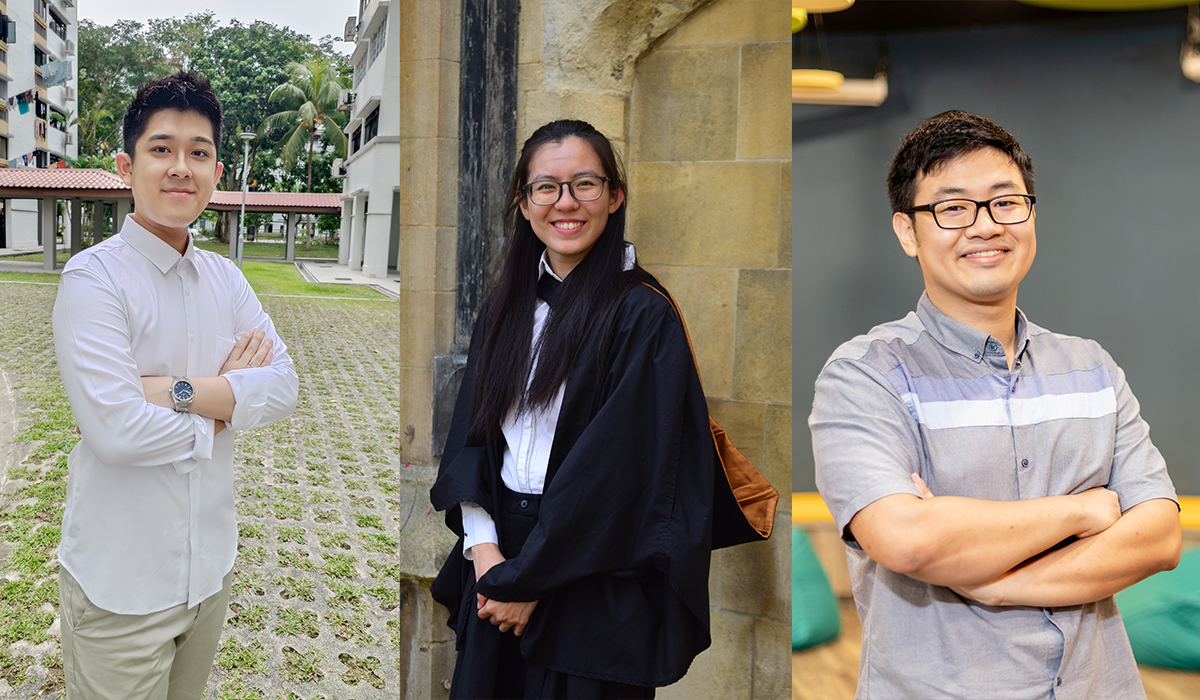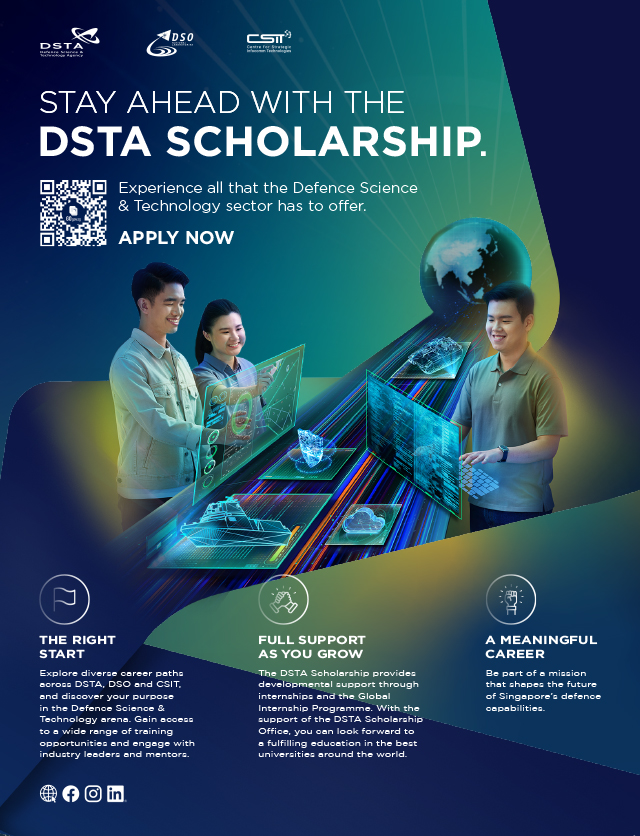Left: Emil Yong Kai Wen is an Engineer in the Command, Control and Communications Development PC at DSTA. He was awarded the DSTA Scholarship and received a Bachelor of Engineering (Electrical Engineering) and a Master of Science (Electrical Engineering) from NUS.
Middle: Tai Ying Fei Felicia is a recipient of the DSTA Scholarship and is an Imaging Radar Engineer at DSO. She holds a Master of Engineering (Information and Computer Engineering) and a Bachelor of Arts (Electrical & Information Sciences) from the University of Cambridge in the United Kingdom (UK).
Right: Leon Zhi-Wei Nathaniel is a recipient of the DSTA Scholarship and received a Double Major Bachelor's degree in Mathematical Sciences and Computer Science from Carnegie Mellon University in the United States (US). He is now an Infocomm Infrastructure Security Engineer at CSIT.
The DSTA Scholarship opens doors for passionate individuals who are looking to push the boundaries in science and cutting-edge technology to strengthen Singapore’s defence capabilities. It offers diverse career pathways through DSTA, DSO National Laboratories (DSO) and the Centre of Strategic Infocomm Technologies (CSIT).
Scholars Emil Yong Kai Wen, Tai Ying Fei Felicia and Leon Zhi-Wei Nathaniel, epitomise the rich opportunities this scholarship presents for those aspiring to excel in science and technology.
Emil’s primary role involves designing customised Command, Control and Communications (C3) systems for military deployment as an Engineer at DSTA. Felicia develops cutting-edge techniques to refine sensor technology at DSO as an Imaging Radar Engineer. Meanwhile, Nathaniel is an Infocomm Infrastructure Security Engineer at CSIT, where his work in malware detection contributes to protecting Singapore’s cyberspace.
Though their journeys are unique, their common mission is clear: strengthening Singapore’s security. We had the privilege of sitting down with them to understand how this scholarship has empowered their remarkable achievements in their diverse fields of expertise.
How did you decide on your career path?
Emil: I’ve always been fascinated by technology. As a child, I loved taking electronic devices - such as Tamiya Cars - apart to understand their inner workings. I realised that electrical engineering was the field that could provide me with the knowledge and skills to turn that childhood curiosity into a meaningful career. I was inspired by the potential to create new technologies, solve real-world problems, and contribute to the ever-evolving world of electronics and automation.
Felicia: I’ve always been fascinated by math and science. Programmes like DSO’s World of Science and Research@Young Defence Scientists Programme provided me with exciting opportunities to see theories come to life through hands-on experiences and challenging research projects. I enjoyed my experience being part of team DSO, so I decided to pursue engineering at university and as a career.
Nathaniel: In 2013, there was a major cyber-attack against Target, one of the largest general merchandise retailers in the US. The data of 70 million customers was stolen, which caused Target to suffer major financial and reputational damage. It made me realise the large impact cyber-attacks can have in the real world and the importance of cybersecurity to protect against such threats. My interest in cybersecurity grew during my internship with CSIT, where I learned more about the work through my project and discussions with my mentor, which made me decide to take it up as a career.
Fascinating! Why did you decide to forge your path with the DSTA Scholarship?
Emil: I first learned about the DSTA Scholarship while I was in National Service. It perfectly matched my aspirations and offered a comprehensive package of benefits. It encompassed all the elements I sought, including overseas educational opportunities, financial support, and a promising career trajectory in a field I’m passionate about. Most importantly, it imbued me with a profound sense of purpose, knowing I would safeguard Singapore’s defence through my work.
Nathaniel: I was already familiar with DSTA as I had taken part in the Young Defence Scientists Programme activities organised by DSTA and DSO in Secondary 4. Due to my positive experience with DSTA, I decided to apply for the scholarship.
Felicia: The DSTA Scholarship is one of the few scholarships that offered flexibility to explore within the Defence Tech Community, providing me the opportunity to pursue technical work and join DSO after graduating.
Emil, how has the scholarship helped enhance your academic career?
With the DSTA Scholarship, I participated in a student exchange programme in Sweden. While on exchange, I gleaned many valuable insights that exposed me to various industry professionals and modern technologies.
Through the DSTA Scholarship, I had the chance to intern at three different Programme Centres at DSTA: the Naval Systems, Air Systems, and Digital Hub, each lasting several months. These internships offered invaluable experiences working closely with DSTA mentors. Their guidance provided deep insights into advanced AI technologies, greatly enhancing my understanding of the subject. This knowledge later proved beneficial during my master’s studies in a related field, focusing on information systems.
Nathaniel, you have a Double Major in Mathematics and Computer Science from Carnegie Mellon University in the United States. Tell us more about your educational experiences there.
I have enjoyed Mathematics since I was young. Solving puzzles has been and still is one of my greatest joys. After my first semester, I chose to add Computer Science as it presented a different flavour of puzzles to me. I was also interested in Computer Science after taking an introductory module in my first semester.
The Computer Science course at my university had very challenging programming exercises. One such exercise was writing Malloc, a library function that allocates memory from scratch. The function implementation is important for ensuring that there are no memory leaks. These exercises helped to build strong programming fundamental skills that are important for my work, even today.
How are you applying what you learnt at the University of Cambridge to your current work, Felicia?
The Engineering curriculum offered extensive exposure to diverse engineering disciplines, allowing for a comprehensive understanding before selecting a specialisation. Recognising the shift toward interdisciplinary projects in industries, I aimed to grasp multiple disciplines to adopt a holistic approach to project work.
I still refer to some of my university lecture notes, which says a lot about how relevant the university course is to my current work. Beyond that direct connection, I think the theoretical foundation built by my education cultivated an intuition for a math-based understanding of signal processing.
Tell us more about your respective areas of work.
Emil: I am currently in the Command, Control and Communications Development PC in DSTA. As a software developer and AI engineer, my main responsibility is to build C3 systems tailored for military deployment. To ensure strong working relationships with our end users, the Singapore Armed Forces (SAF), I conduct sprint meetings to facilitate project updates and gain insights into their specific requirements and operational processes. These meetings gave me an in-depth understanding of the intricacies of Singapore’s military systems. It also helps to ensure that the software I develop aligns effectively with their needs. On a regular working day, you will find me coding at my desk and bringing these critical components to life.
The realisation that the software I create indirectly safeguards the lives and well-being of people around me gives me immense pride and motivation.
Felicia: I am an Imaging Radar Engineer with DSO’s Sensors Division. I often work with real data collected from experiments to develop techniques that improve the quality of radar images formed by airborne systems.
My job scope involves reading research papers on new signal processing algorithms that can improve the quality of radar images formed, experimenting with it on simulators, designing outdoor experiments to test the robustness of our algorithm and conducting post-experiment data analysis to validate and quantify improvements.
The nature of research and development (R&D) in defence means that we are often at the forefront of technology and our work centres on pushing the boundaries of science and tech. Our work also directly impacts our users in the SAF, which helps me to see how our work fits into the bigger picture of Singapore’s defence.
Nathaniel: My work deals with malware detection. We conduct static and dynamic analysis on suspected malicious software and develop algorithms to automatically detect malicious software. This is increasingly important with the rise of cybercrimes and sophisticated threat actors. Besides malware detection, I also do reverse engineering to find unique features of the malware. Then, I develop solutions to detect them and better protect our systems. My role in malware detection supports CSIT in protecting Singapore’s key infrastructure and systems against very sophisticated threat actors with malicious intent beyond cybercrimes.
Emil, what impact do you hope to have through your career?
I aspire to continue cultivating the technical competencies essential for software development while concurrently honing my leadership and project management skills. At DSTA, I am given the opportunity to build a strong technical foundation and work on my soft skills, like teamwork and problem-solving, when I handle interesting projects.
What are the possibilities for the people who hope to join your respective organisations?
Emil: Working in DSTA provides a unique opportunity to gain insight into the behind-the-scenes intricacies of Singapore’s defence efforts while also being able to engage directly with cutting-edge technologies in the market. If you’re all about getting hands-on with cool tech and using your engineering skills for a bigger purpose, DSTA’s the place to be. At DSTA, staff are offered multiple career pathways to meet their own aspirations.
Felicia: For starters, we have two career tracks – a technical track that provides opportunities to build deep technical expertise; and a management track that empowers those who prefer to lead and manage research programmes.
Regardless of what you choose, DSO has a suite of learning programmes to support your growth including a range of in-service scholarships for those interested in pursuing further studies.
Nathaniel: There are endless possibilities for people working at CSIT. One of the things I like most about working at CSIT is the freedom to explore and try new things. We are always encouraged to think of new and better work processes, and our bosses also make sure to set aside protected time for us to focus on doing research to expand our knowledge in a particular area. This empowers the individual to take charge of their own work and research direction.



